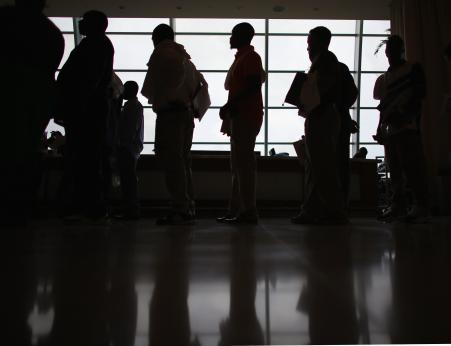By Jessica Menton -

U.S. employers added 173,000 jobs in August, less than widely expected, but the unemployment rate still edged down to 5.1 percent, its lowest level since April 2008, the Labor Department said Friday. Meanwhile, wage growth - which has been stagnant for years -- edged up slightly more than anticipated to 2.2 percent.
Somewhat troubling, though, the labor force participation rate continues to drop, which indicates more Americans giving up on finding work.
The report was forecast to show employers adding 220,000 jobs last month and the unemployment rate was expected to fall to at 5.2 percent, according to analysts polled by Thomson Reuters.
Even so, amid the recent stock market turmoil and concerns of a slowing global economy, economists question whether the U.S. is strong enough to move away from crisis-level interest rates. Many economists are still not seeing the accelerated growth that suggests the economy needs to slow -- or that businesses are experiencing wage pressure.
Wages and salaries increased modestly by 2.2 percent from 1.9 percent a year earlier, according the Labor Department’s Employment Cost Index.
“Wage growth is still really slow,” said Dan North, chief economist at Euler Hermes. Two of the Federal Reserve’s major mandates -- employment and inflation -- are still off of the Federal Reserve’s target, North explained. “This argues against the central bank raising rates this month,” he said.
The Federal Reserve's Next Moves
Friday's jobs report is the last monthly unemployment reading ahead of the Federal Reserve’s next meeting on Sept. 16-17. The financial markets reacted with mixed emotions to the July numbers because the report didn’t completely solidify whether the Fed would actually hike rates in September, or hold off until later.
With the unemployment rate falling to the lowest level since April 2008, it could offer further evidence the U.S. economy is on strong enough footing to absorb the impact of a Federal Reserve interest rate hike, which many economists had expected in September. The upward adjustment would be the first in nearly a decade. Interest rates remain at historic lows since the financial crisis in 2008.
However, in the midst of the recent stock market turmoil over China’s slowing economy, part of the Fed’s consideration not to raise rates will be global unease. “While China has slowed, its implications are still making financial markets nervous,” said William Spriggs, chief economist at the AFL-CIO.
Mark Hamrick, Washington bureau chief at Bankrate.com, agrees. “The consensus has definitely shifted from early August,” Hamrick said, explaining the majority of economists are now looking for the Fed to delay at this month’s meeting. Toughly 40 percent expecting the Fed to lift in September and the 60 percent looking for October and beyond, Hamrick said, citing a Bankrate.com survey.
The U.S. had previously added at least 200,000 jobs per month for 12 consecutive months following February’s strong jobs report, a feat not seen in 20 years. However, the reports over the last two quarters haven’t been as stellar.
“Job growth has tapered greatly in the last three months,” said Spriggs. “My hope is the Fed will look at the numbers and say they still need more information before making a decision”
Participation Rate Remains Near 40-Year Low
The number of Americans who have been out of work for 27 weeks or longer was essentially unchanged last month, at 2.2 million, constituting 27.7 percent of the unemployed. Meanwhile, many Americans who work part-time jobs want to work full time, and nearly two-thirds who are able to work have dropped out of the labor force, the highest proportion opting out of the workforce since the 1970s.
Unemployment Rate vs Labor Force Participation Rate | StartClass
The labor-force participation rate remains at its lowest level since October 1977, a 38-year low. That rate fell to 62.6 percent from the prior month, according to the report released Friday.
The participation rate still hovers at a nearly 40-year low because improvements in the labor market are being offset by the structural headwinds of demographic change: Baby boomers are retiring and young professionals are going back to school.
Energy Job Losses
To be sure, pockets of the U.S. job market are suffering. The energy industry has been hit hard of late. The precipitous drop in oil prices over the last year has led to job losses related to the oil and mining sector as investment in those areas declines. And economists expect the job losses to continue.
In August, employment in mining fell for the seventh month in a row. Since a recent high in December 2014, employment in mining has declined by 90,000, with losses concentrated in support activities for mining.
